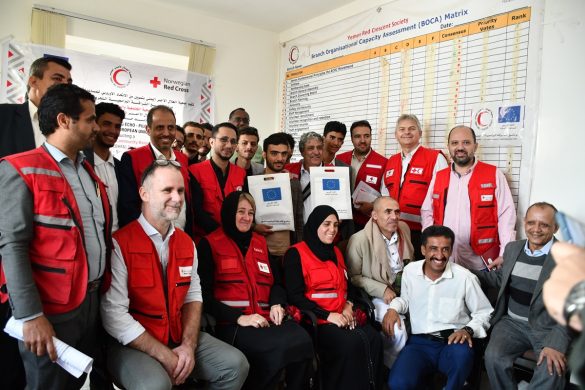SANAA, 7. April 2010 (IRIN) – En række nødhjælpsorganisationer advarer om at Yemen er truet af en fødevarekrise, hvis landet ikke får mere hjælp inden juni.
FNs fødevareprogram, WFP, siger at organisationen vil løbe tør for fødevarehjælp i Yemen ved udgangen af juni, hvis ikke den modtager flere midler.
Aid organizations are warning of a food crisis in Yemen unless international food aid funding is dramatically increased before June 2010.
The World Food Programme (WFP) says it has only received a quarter of its annual budget for 2010 (US$25.6 million out of $103.2 million), and will run out of food for 3.2 million people by the end of June.
According to several aid agencies and NGOs, the 250,000 Yemeni internally displaced persons (IDPs) in the north and 19,000 mainly Somali refugees in the south are at greatest risk of starvation.
“If WFP stopped its distribution of food, it would be a catastrophic scenario,” said Kamel Ben Abdallah, head of Young Child Survival and Development for the UN Children’s Fund (UNICEF) in Yemen. “Without regular food distribution, the situation would definitely deteriorate and they [refugees and IDPs] would starve.”
Pablo Marco Blanco, head of Médecins Sans Frontières (MSF), said he was concerned that a halt to food distribution in IDP camps in the north would accelerate the return of displaced families to their places of origin in Saada Governorate, where basic requirements, such as food, health and education, are not yet available.
“Most of the population in the [three] al-Mazraq camps [in Hajjah Governorate] are getting their food from WFP distribution, so a potential stop in the distributions could have a strong impact,” he said, adding that MSF was ready to scale up its nutritional services in the camps, with some targeted food distribution for the most vulnerable. “But we will not be able to cover the WFP gap.”
Andrew Moore, country director for Save the Children, said his organization could not take over WFP’s food distribution role. “We do not have enough funds; our US-funded health and nutrition programme is complementary to WFP,” he said.
Because of funding shortfalls, in February WFP reduced food rations to 72 percent of the required daily kilocalories for IDPs and to 90 percent for refugees; in March it rations were up slightly to 85 percent for IDPs, but down to 75 percent for refugees.
Only by borrowing $4.8 million from its Immediate Response Account (a kind of contingency fund for disasters) has it been possible for the agency to distribute food until the end of June.
One third of population “food insecure”
Apart from IDPs and refugees, one third of Yemen’s 23 million people are “food insecure”, and of these, 2.7 million are ”severely food insecure”, according to a recently released WFP report entitled Comprehensive Food Security Survey 2010.
In the cases of “severe food insecurity”, households spend up to 30 percent of their income on bread alone. They have virtually no balanced diet and often have to skip meals.
Yemen has one of the highest rates of malnutrition in the world. Some 46 percent of all Yemeni children under five are underweight, the fourth highest rate in the world, according to the UN Development Programme’s Human Development Report 2009.
Some 58 percent of children are malnourished, or have stunting, second only to Afghanistan, according to UNICEF’s report Tracking Progress on Child and Maternal Nutrition 2009.
“Without WFP, we will see more cases of severe malnutrition,” said Ben Abdallah of UNICEF. “This means UNICEF’s burden will increase and we are already unable to cover all the severe cases in Yemen. Without WFP the situation would be dramatic.”
Food insecurity has long plagued Yemen, but several factors have exacerbated the situation recently.
Firstly, Yemen has been hard hit by the hike in global food prices over the past two years. Secondly, the country’s oil revenues have been falling. Thirdly, the financial crisis has had an adverse effect on remittances from Yemenis working abroad.
“It is a triple F crisis,” Giancarlo Cirri, WFP country director in Yemen, said referring to food, fuel and financial.
Other factors are the high population growth rate (one of the highest in the world at 3 percent) and severe water shortages.















